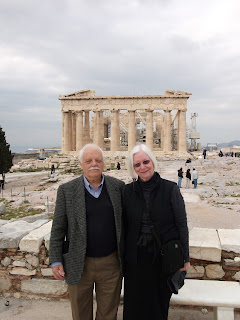We spent a pleasant 3 days with Alice, staying in her house on the edge of Hampstead Heath. The house, and situation seems perfect: one gets to it from Victoria station with a single bus ride; there is a vast expanse of green to walk on across the street (the heath); there are small shops, butcher, coffee bar, etc., within a short block; there is a small, manageable back yard, the house is charming, and finally, London is at one's fingertips. Monday we went with Alice for lunch with an old friend, Alice meeting her for the first time. Tuesday we just stayed in the neighborhood. On Wednesday, which was beautiful, we went for a walk along the Thames. We took the underground to the Embankment station, then walked upstream along the left bank of the Thames, past some fine plantings and statues to Westminster Bridge. Then over the bridge, with a fine view of Parliament to the right bank and, continuing upstream to Lambeth Bridge, where we stopped for a coffee. Crossing Lambeth Bridge, we walked back through the Westminster Abbey yard and Parliament Square where news media were setting up for interviews because the budget was being presented that day (I think), and through some side streets to St. James Park. Then into the park for a lunch appointment at a restaurant there. The park was crowded with people enjoying the sun. The meal was for the most part disappointing, and we had to wait over an hour to be served; as a result we were told that the meal would be free of charge. Unfortunately I neglected to take any pictures of this expedition. That evening Mary Jo and I went to Gatwick where we spent the night in the Yotel there (minuscule room) in preparation for an early flight to Ireland.
Our last week on this trip finished in Cork City, Ireland, where we stayed with our friends with Martin and Jeanne Stynes. We talked a lot, visited with Sebastian Franz, a mathematician friend, who came down from Limerick to see us, walked around the city visiting places with which we are familiar, and were kindly taken by Martin on several very nice hikes in and near Cork City. Some pictures are attached.
The trip home was without incident, except that Mary Jo's suitcase had not yet arrived. It arrived the next day.
The river Lee, on our walk to Blackrock Castle
Mary Jo and Martin Stynes, the castle in the distance
Mary Jo and martin at the Fota gardens
Italian garden at Fota







































